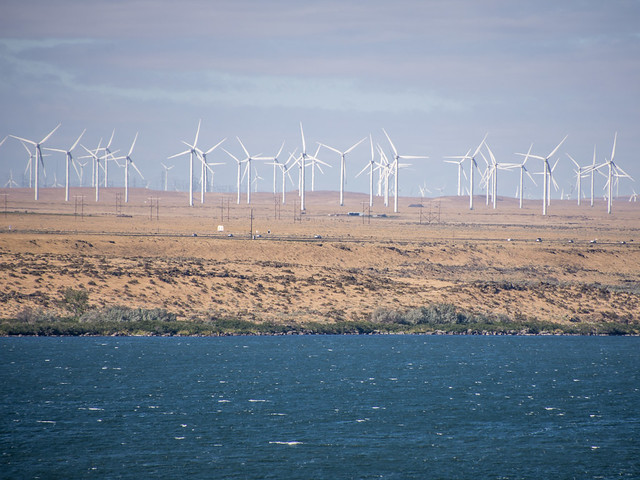Thursday, 14 June 2018
The Transition to Renewable Energy in Saskatchewan
The University of Saskatchewan, in collaboration with World Wildlife Fund Canada, hosted two renewable energy panel discussions on May 28, 2018. The following article summarizes some of the key points raised by presenters.
Meeting Saskatchewan’s Long-term Energy Needs
Douglas Opseth, Director of Generation Asset Management and Resource Planning at SaskPower, started off the morning’s discussion by outlining the challenges the company faces in meeting Saskatchewan’s long-term energy needs. There is a growing demand for electricity; however, Saskatchewan’s coal and natural gas plants and wind farms are aging and SaskPower is spending a lot on maintenance and building new facilities. The company plans to reduce emissions by 40% by 2030 with 50% renewables (30% wind, 15% hydro, 5% solar and biomass), but the other half of the mix is more uncertain. SaskPower would like to continue using coal, which is available in province. It’s still unclear whether this will be allowed under federal regulations. Natural gas is a good fit with renewables as it’s flexible; however, there are concerns about a sufficient supply if everyone switches to natural gas and/or if there is increased concern about fracking.
Guy Lonechild, CEO, First Nations Power Authority, pointed out that many First Nations communities have no reliable source of power and continue to use diesel. Opseth explained that the northern transmission line is completely separate and is only connected to the south through Manitoba. It is a long line over rough terrain and experiences a great many lightning strikes. In addition, northern residents are more vulnerable to power outages as the majority heat their homes with electricity.
Lonechild would like to see the Small Producers program expanded to 1 megawatt as this could help relieve power fluctuations in many communities. He sees lots of opportunity for geothermal, which is expensive but could also supply heat and be used in conjunction with greenhouses. Lonechild views partnerships on renewable energy projects as a valuable opportunity for First Nations people to obtain education, training, and jobs. He pointed to SIGA’s success, identifying renewable energy as a new opportunity for Saskatchewan’s Indigenous people to be involved in the provincial economy. Lonechild also raised the possibility of increased self-government that would include environmental assessments and monitoring, wildlife management, and community energy. In closing, Lonechild emphasized bold thinking as we look to 2050 and beyond. He stated that Saskatchewan was a pioneer in carbon capture: why not look at battery storage?
Lonechild’s interest in community energy planning was shared by Ray Orb, President, Saskatchewan Association of Rural Municipalities. Orb stated that rural residents recognize the climate is changing but are strongly opposed to wind farms. People on acreages moved to the country to enjoy the wide-open prairie view and don’t want to live across from a wind farm. There is more support for solar farms on wasteland and SARM has identified an opportunity for rural municipalities, such as Corman Park, to provide power to nearby cities. Orb also suggested looking at new hydro projects with their spin-off benefits of irrigation, drinking water, recreation, and flood mitigation.
Opseth explained that renewables present new challenges. SaskPower currently has full control over power generation. They’ll lose that control as they introduce variable energy sources such as wind and solar. This is particularly challenging in Saskatchewan which has a very flat load demand as most electricity is sold to commercial customers that operate 24/7 (as opposed to a more residential region where there are peaks at different times of the day). SaskPower was set up to be the province’s sole energy provider. Individuals and groups are now introducing self-generation; however, they all want SaskPower as a backup.
A member of the audience emphasized the need for increased efficiency and energy conservation. Opseth noted that Saskatchewan has more transmission lines than anywhere else in North America. SaskPower is looking at ways to reduce losses that are inherent in moving energy over large distances to a dispersed population. One option is greater regional production. The company is also doing more work with industrial customers to enhance efficiency and energy conservation.
Habitat-Friendly Renewable Energy
The goal of World Wildlife Fund Canada is to work with key partners in all sectors to advance science-based, solutions-oriented approaches to conservation problems. The organization recognizes that a large-scale transition to renewable energy will require new uses of landscapes and seascapes and have started developing a tool that maps both sustainable energy potential and areas with significant conservation value. The tool isn’t intended to bypass the regulatory process but is instead a broad brushstrokes approach to identifying potential sites, saving time and money by avoiding conflict with community and wildlife interests and enabling developers, governments, and communities to make better and faster decisions.
The tool was initially developed for New Brunswick and the Bay of Fundy and is now being rolled out to Alberta and Saskatchewan. Using a high conservation value framework (previously used by the Forest Stewardship Council), the tool maps species diversity, ecosystems, threatened habitats, ecosystem services, community and cultural values. It combines regulated (Saskatchewan’s wind directive, Alberta’s solar directive, historic sites) and non-regulated elements (important bird areas, endangered species, intact forests, potential for agriculture) with additional factors such as wind speed, hours of sunlight, distance from transmission lines. The focus in Alberta and Saskatchewan is on identifying opportunities for large-scale wind and solar farms.
The World Wildlife Fund is looking for partners, such as the University of Saskatchewan, to help them enhance the tool. For example, the community and cultural values need to be strengthened and they see potential for enhancing the tool’s predictive value based on past projects and shifting land use.
Photos: Esmeralda, Nevada, Solar Reserve; Columbia River Wind Farm
Labels:
First Nations,
Renewable Energy,
Rural,
Saskatchewan,
SaskPower,
Solar,
University,
Wildlife,
Wind


